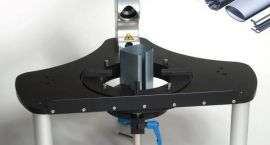Cutting quality control costs down to size

Roll forming is an effective way to produce continuous strips of metal with a complex, constant profile. A family-owned company in Bavaria, data M Sheet Metal Solutions GmbH, is changing approaches to roll forming quality control.
Roll forming involves using a series of heavy rollers to create long metal strips with continuous, complex profiles. Think of truck bodies, lightweight beams, crash barriers - there are thousands of applications.
Quality control is important in each of these applications. The cross-section of the strip must be set precisely from the outset. Normally, this involves scanning with an array of lasers that map the cross section. This is effective, but also complex, expensive and inflexible. Data M Sheet Metal Solutions GmbH has now developed a new approach that is smaller, cheaper and highly portable.
Smaller, simpler, and more cost effective
Dipl.-Ing. Albert Sedlmaier, General Manager of data M Sheet Metal Solutions GmbH, explains how their new product made a difference. "Laser scanning in roll forming is not new", he said. "It delivers accurate results."
"However, it is expensive, inflexible and has limitations. Traditional laser scanning needs multiple cameras, arranged in a ring, to cover the entire profile. It also must be fixed 'in line', scanning finished material as it comes off the production line. Our COPRA ProfileScan Desktop overcomes many of these shortcomings."
The product grew out of the Eurostars RF EXPERT project. This set out to accurately model the roll forming process, identifying potential problems in advance and improving quality control. Partner company Profilmetall GmbH and Mondragon University provided a testbed for the device, producing industrial and simple shaped profiles respectively. The results from this work transferred into the development of COPRA.The new system uses a single camera coupled with a turntable.
It works by place a sample into platform, which is then rotated through 360 degrees while the laser scans. This needs only one single camera, and, because it rotates, it scans more of the surface than a fixed array. This is better when scanning complex shapes such as slotted products, where fixed lasers can encounter 'blind spots'. Using the rotating platform reveals interior areas even through small gaps.
The COPRA ProfileScan Desktop is simple to use. It comes complete with its own integrated software. It connects directly to a PC or laptop via a simple USB cable, and will run on most Windows-based machines. It is portable – it has its own carrying case, yet is simple to integrate into the production. Perhaps most importantly of all, it is less than one-quarter of the price of fixed array scanners.
Broadening markets and boosting employment
"This device has been a real success for us," explained Dipl.-Ing. Sedlmaier. "We had already built a strong reputation for expertise in roll forming software, but this has elevated our profile. We have already built and sold 40 of these devices, and increased our customer geography, including reaching the Chinese market for the first time." The company has taken on two full-time employees to deal with demand.
Provided by Eurostars



















